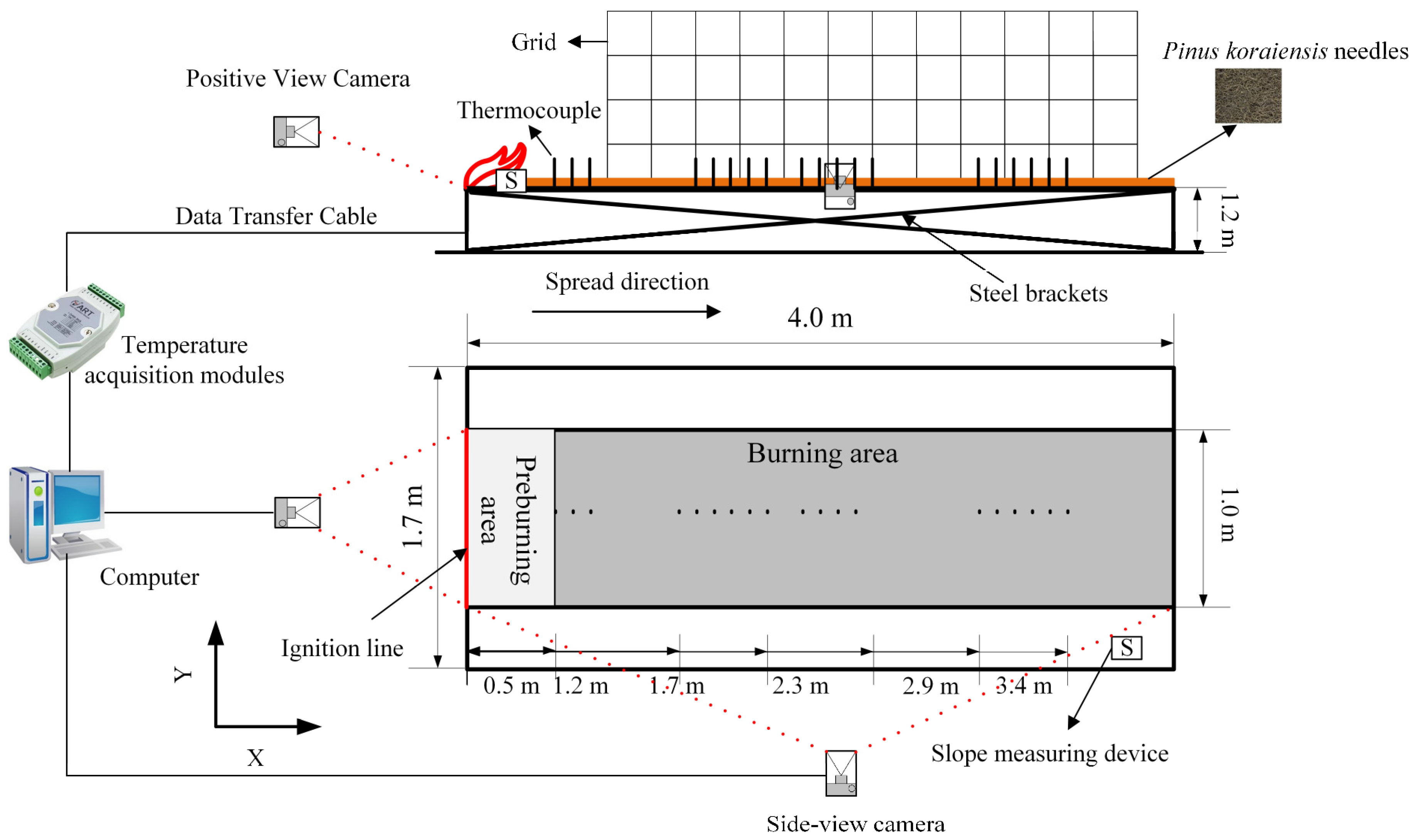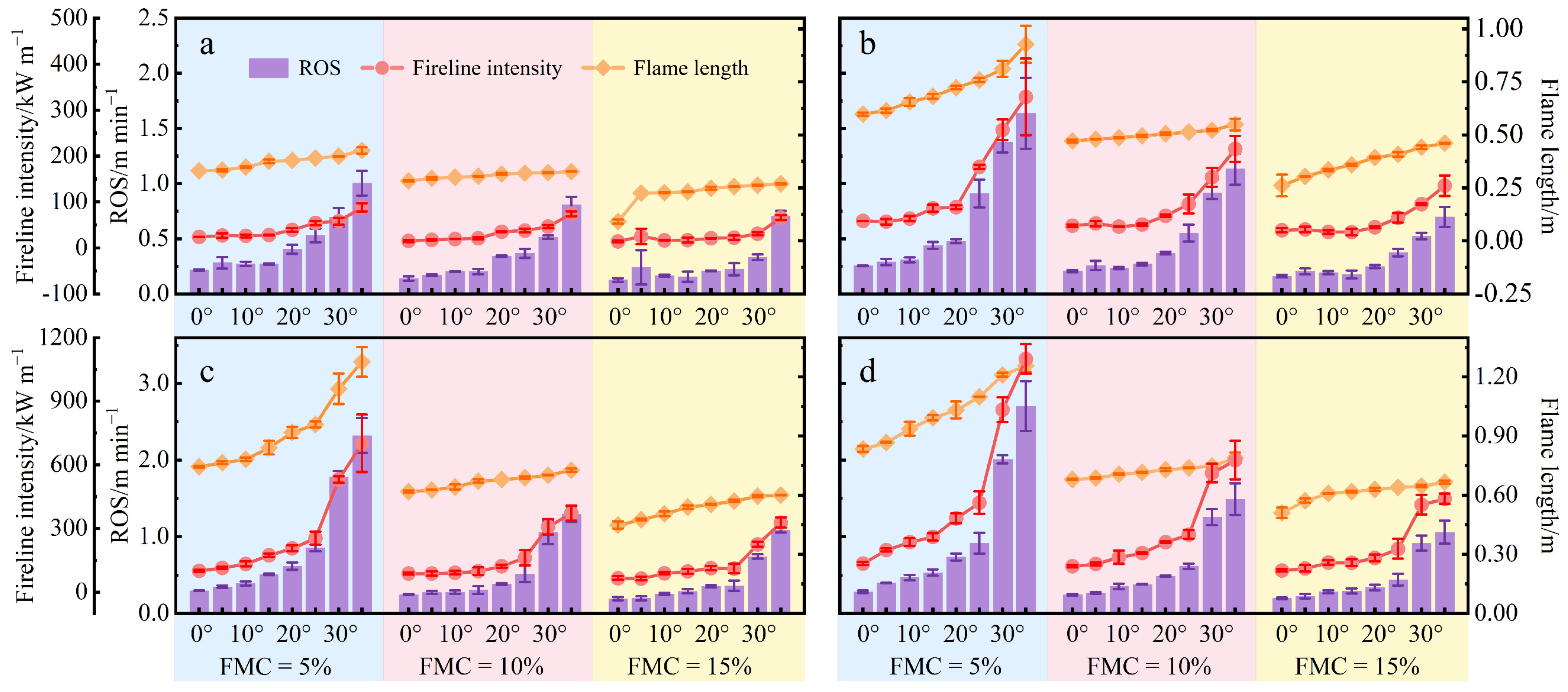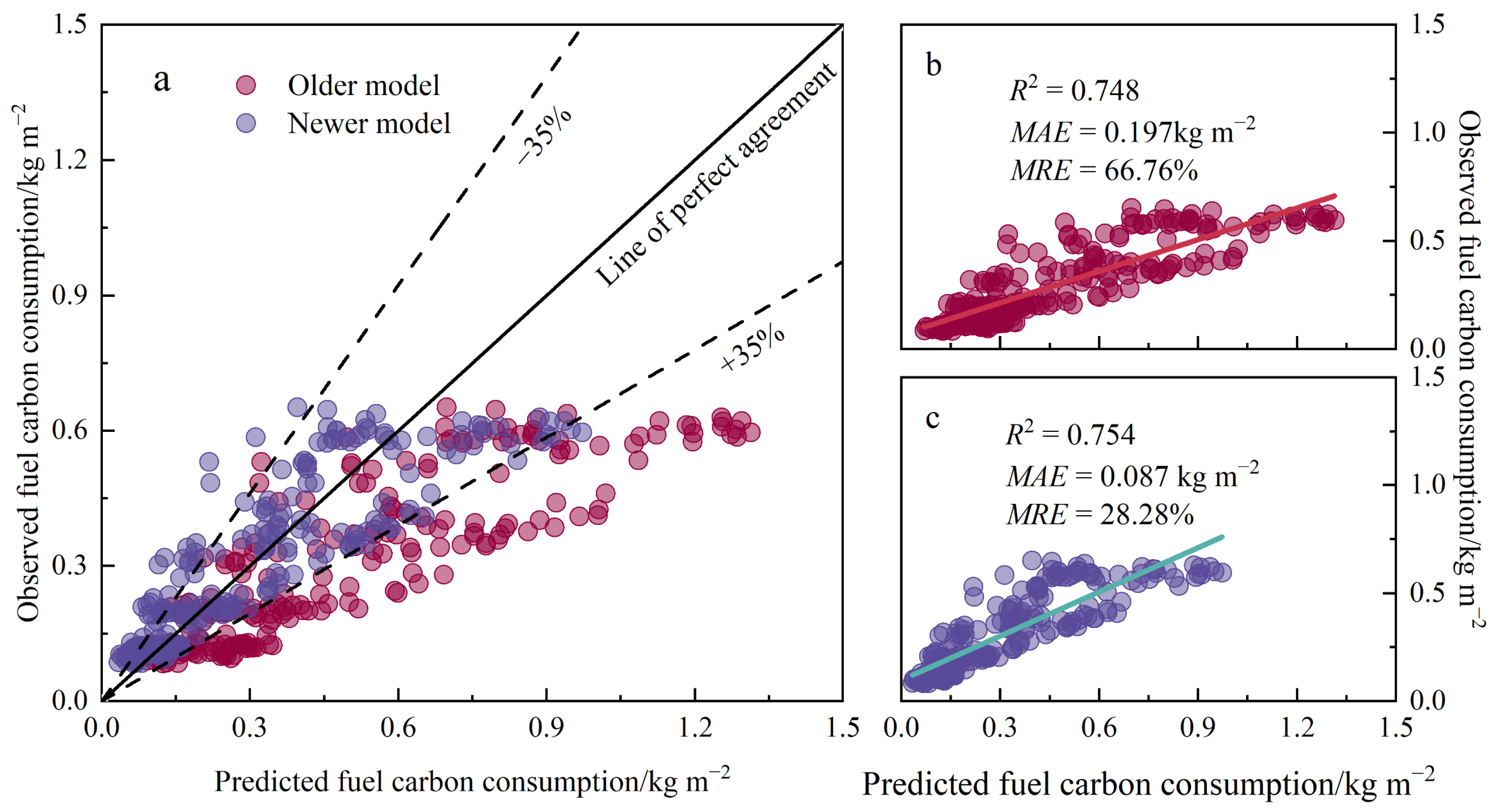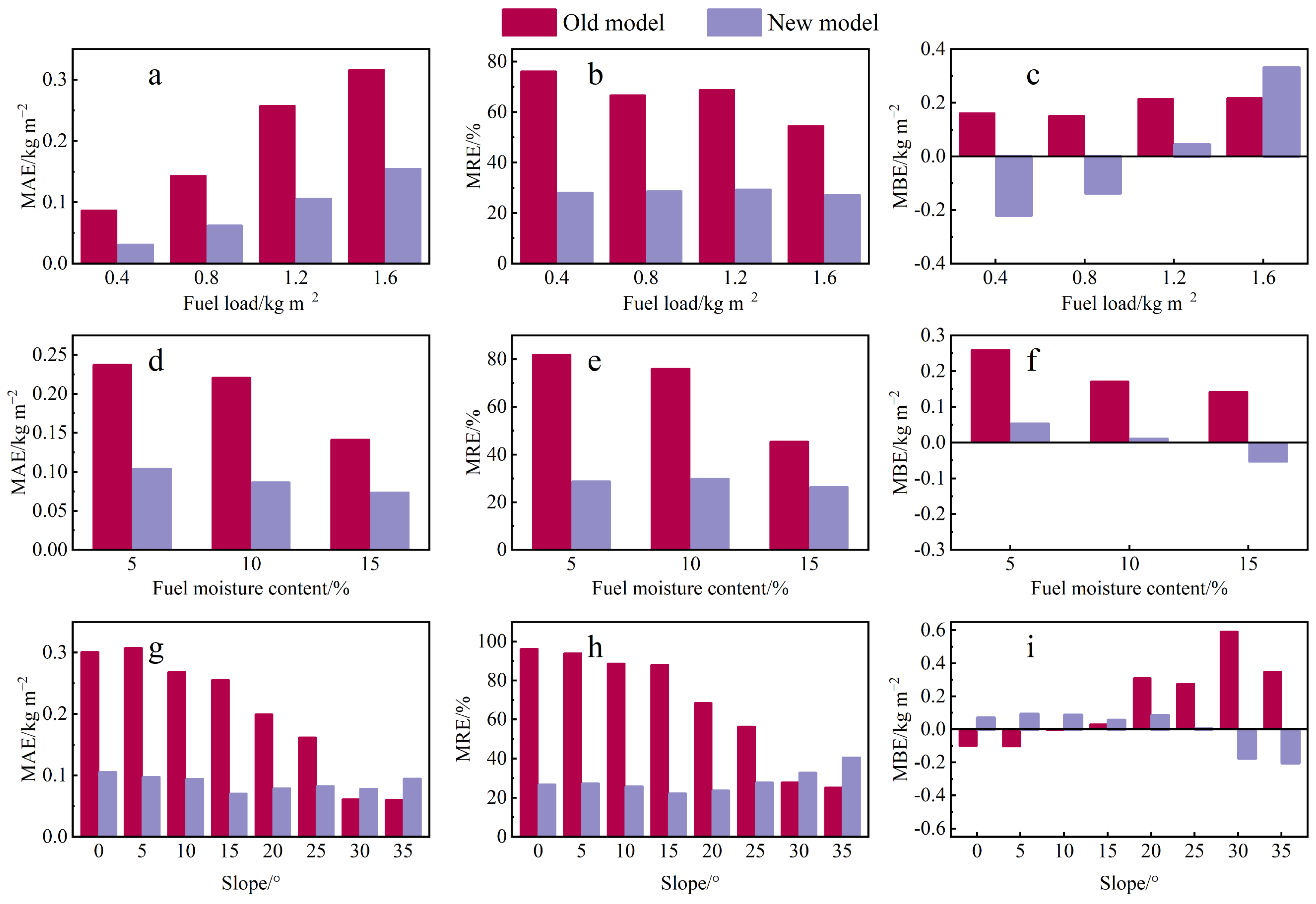Carbon Emission Prediction Following Pinus koraiensis Plantation Surface Fuel Combustion Based on Carbon Consumption Analysis
Abstract
1. Introduction
2. Materials and Methods
2.1. Combustion Experiment
2.1.1. Fuel Pretreatment
2.1.2. Laboratory Combustion Experiments
2.1.3. Fuel Carbon Consumption Measurement
2.2. Modelling Fuel Carbon Consumption
2.2.1. Modelling of Fuel Consumption and Carbon Consumption
2.2.2. Fuel Carbon Consumption Model
2.3. Data Processing and Analysis
3. Results and Analysis
3.1. Data Statistics of Combustion Experiment
3.2. Fire Behaviour Characteristics
3.2.1. Observed ROS
3.2.2. Flame Length
3.2.3. Fuel Consumption
3.2.4. Fireline Intensity
3.3. Modelling of Fuel Carbon Consumption
3.3.1. Relationship Between Fuel Consumption and Carbon Consumption
3.3.2. Fuel Carbon Consumption Model Prediction Error
4. Discussion
4.1. Effect of Different Influences on Fire Behaviour Characteristics
4.2. Error Analysis of Model Predictions of Fuel Combustion Carbon Consumption
4.3. Model Applications, Limitations, and Improvements
5. Conclusions
Author Contributions
Funding
Institutional Review Board Statement
Informed Consent Statement
Data Availability Statement
Conflicts of Interest
References
- Canadell, J.G.; Raupach, M.R. Managing Forests for Climate Change Mitigation. Science 2008, 320, 1456–1457. [Google Scholar] [CrossRef] [PubMed]
- Fernández-Martínez, M.; Vicca, S.; Janssens, I.A.; Sardans, J.; Luyssaert, S.; Campioli, M.; Chapin Iii, F.S.; Ciais, P.; Malhi, Y.; Obersteiner, M.; et al. Nutrient Availability as the Key Regulator of Global Forest Carbon Balance. Nat. Clim. Change 2014, 4, 471–476. [Google Scholar] [CrossRef]
- Steffen, W.; Rockström, J.; Richardson, K.; Lenton, T.M.; Folke, C.; Liverman, D.; Summerhayes, C.P.; Barnosky, A.D.; Cornell, S.E.; Crucifix, M.; et al. Trajectories of the Earth System in the Anthropocene. Proc. Natl. Acad. Sci. USA 2018, 115, 8252–8259. [Google Scholar] [CrossRef]
- Lal, R. Forest Soils and Carbon Sequestration. For. Ecol. Manag. 2005, 220, 242–258. [Google Scholar] [CrossRef]
- Canadell, J.G.; Le Quéré, C.; Raupach, M.R.; Field, C.B.; Buitenhuis, E.T.; Ciais, P.; Conway, T.J.; Gillett, N.P.; Houghton, R.A.; Marland, G. Contributions to Accelerating Atmospheric CO2 Growth from Economic Activity, Carbon Intensity, and Efficiency of Natural Sinks. Proc. Natl. Acad. Sci. USA 2007, 104, 18866–18870. [Google Scholar] [CrossRef] [PubMed]
- Galik, C.S.; Jackson, R.B. Risks to Forest Carbon Offset Projects in a Changing Climate. For. Ecol. Manag. 2009, 257, 2209–2216. [Google Scholar] [CrossRef]
- Just, M.G.; Hohmann, M.G.; Hoffmann, W.A. Invasibility of a Fire-Maintained Savanna–Wetland Gradient by Non-Native, Woody Plant Species. For. Ecol. Manag. 2017, 405, 229–237. [Google Scholar] [CrossRef]
- Chang, Y.; Zhu, Z.; Feng, Y.; Li, Y.; Bu, R.; Hu, Y. The Spatial Variation in Forest Burn Severity in Heilongjiang Province, China. Nat. Hazards 2016, 81, 981–1001. [Google Scholar] [CrossRef]
- Andela, N.; Morton, D.C.; Giglio, L.; Chen, Y.; Van Der Werf, G.R.; Kasibhatla, P.S.; DeFries, R.S.; Collatz, G.J.; Hantson, S.; Kloster, S.; et al. A Human-Driven Decline in Global Burned Area. Science 2017, 356, 1356–1362. [Google Scholar] [CrossRef]
- Van Der Werf, G.R.; Randerson, J.T.; Giglio, L.; Van Leeuwen, T.T.; Chen, Y.; Rogers, B.M.; Mu, M.; Van Marle, M.J.E.; Morton, D.C.; Collatz, G.J.; et al. Global Fire Emissions Estimates during 1997–2016. Earth Syst. Sci. Data 2017, 9, 697–720. [Google Scholar] [CrossRef]
- Bowman, D.M.J.S.; Williamson, G.J.; Price, O.F.; Ndalila, M.N.; Bradstock, R.A. Australian Forests, Megafires and the Risk of Dwindling Carbon Stocks. Plant Cell Environ. 2021, 44, 347–355. [Google Scholar] [CrossRef] [PubMed]
- Cullen, A.C.; Axe, T.; Podschwit, H. High-Severity Wildfire Potential—Associating Meteorology, Climate, Resource Demand and Wildfire Activity with Preparedness Levels. Int. J. Wildland Fire 2021, 30, 30–41. [Google Scholar] [CrossRef]
- Higuera, P.E.; Abatzoglou, J.T. Record-setting Climate Enabled the Extraordinary 2020 Fire Season in the Western United States. Glob. Change Biol. 2021, 27, 1–2. [Google Scholar] [CrossRef]
- Jain, P.; Castellanos-Acuna, D.; Coogan, S.C.P.; Abatzoglou, J.T.; Flannigan, M.D. Observed Increases in Extreme Fire Weather Driven by Atmospheric Humidity and Temperature. Nat. Clim. Change 2022, 12, 63–70. [Google Scholar] [CrossRef]
- Van Oldenborgh, G.J.; Krikken, F.; Lewis, S.; Leach, N.J.; Lehner, F.; Saunders, K.R.; Van Weele, M.; Haustein, K.; Li, S.; Wallom, D.; et al. Attribution of the Australian Bushfire Risk to Anthropogenic Climate Change. Nat. Hazards Earth Syst. Sci. 2021, 21, 941–960. [Google Scholar] [CrossRef]
- Walker, X.J.; Baltzer, J.L.; Cumming, S.G.; Day, N.J.; Ebert, C.; Goetz, S.; Johnstone, J.F.; Potter, S.; Rogers, B.M.; Schuur, E.A.G.; et al. Increasing Wildfires Threaten Historic Carbon Sink of Boreal Forest Soils. Nature 2019, 572, 520–523. [Google Scholar] [CrossRef]
- Ndalila, M.N.; Williamson, G.J.; Bowman, D.M.J.S. Carbon Dioxide and Particulate Emissions from the 2013 Tasmanian Firestorm: Implications for Australian Carbon Accounting. Carbon Balance Manag. 2022, 17, 7. [Google Scholar] [CrossRef]
- Walker, X.J.; Rogers, B.M.; Veraverbeke, S.; Johnstone, J.F.; Baltzer, J.L.; Barrett, K.; Bourgeau-Chavez, L.; Day, N.J.; De Groot, W.J.; Dieleman, C.M.; et al. Fuel Availability Not Fire Weather Controls Boreal Wildfire Severity and Carbon Emissions. Nat. Clim. Change 2020, 10, 1130–1136. [Google Scholar] [CrossRef]
- Zheng, B.; Ciais, P.; Chevallier, F.; Chuvieco, E.; Chen, Y.; Yang, H. Increasing Forest Fire Emissions despite the Decline in Global Burned Area. Sci. Adv. 2021, 7, eabh2646. [Google Scholar] [CrossRef] [PubMed]
- Sommers, W.T.; Loehman, R.A.; Hardy, C.C. Wildland Fire Emissions, Carbon, and Climate: Science Overview and Knowledge Needs. For. Ecol. Manag. 2014, 317, 1–8. [Google Scholar] [CrossRef]
- Wang, C.; Gower, S.T.; Wang, Y.; Zhao, H. The Influence of Fire on Carbon Distribution and Net Primary Production of Boreal Larix Gmelinii Forests in North-Eastern China. Glob. Change Biol. 2001, 7, 719–730. [Google Scholar] [CrossRef]
- Seiler, W.; Crutzen, P.J. Estimates of Gross and Net Fluxes of Carbon between the Biosphere and the Atmosphere from Biomass Burning. Clim. Change 1980, 2, 207–247. [Google Scholar] [CrossRef]
- Ward, D.E.; Hao, W.M. Projections of emissions from burning of biomass for use in studies of global climate and atmospheric chemistry. Paper 91-128.4. In Proceedings of the 84th Annual Meeting and Exhibition, Vancouver, BC, Canada, 16–21 June 1991; Air and Waste Management Association: Pittsburgh, PA, USA, 1991. 16p. [Google Scholar]
- Ball, R. Regulation of Atmospheric Carbon Dioxide by Vegetation Fires. Clim. Res. 2014, 59, 125–133. [Google Scholar] [CrossRef]
- Kurz, W.A.; Dymond, C.C.; White, T.M.; Stinson, G.; Shaw, C.H.; Rampley, G.J.; Smyth, C.; Simpson, B.N.; Neilson, E.T.; Trofymow, J.A.; et al. CBM-CFS3: A Model of Carbon-Dynamics in Forestry and Land-Use Change Implementing IPCC Standards. Ecol. Model. 2009, 220, 480–504. [Google Scholar] [CrossRef]
- Ramo, R.; Roteta, E.; Bistinas, I.; Van Wees, D.; Bastarrika, A.; Chuvieco, E.; Van Der Werf, G.R. African Burned Area and Fire Carbon Emissions Are Strongly Impacted by Small Fires Undetected by Coarse Resolution Satellite Data. Proc. Natl. Acad. Sci. USA 2021, 118, e2011160118. [Google Scholar] [CrossRef]
- Liu, N. Wildland Surface Fire Spread: Mechanism Transformation and Behavior Transition. Fire Saf. J. 2023, 141, 103974. [Google Scholar] [CrossRef]
- Garcia-Hurtado, E.; Pey, J.; Baeza, M.J.; Carrara, A.; Llovet, J.; Querol, X.; Alastuey, A.; Vallejo, V.R. Carbon Emissions in Mediterranean Shrubland Wildfires: An Experimental Approach. Atmos. Environ. 2013, 69, 86–93. [Google Scholar] [CrossRef]
- Ping, X.; Chang, Y.; Liu, M.; Hu, Y.; Yuan, Z.; Shi, S.; Jia, Y.; Li, D.; Yu, L. Fuel Burning Efficiency under Various Fire Severities of a Boreal Forest Landscape in North-East China. Int. J. Wildland Fire 2021, 30, 691–701. [Google Scholar] [CrossRef]
- Ottmar, R.D. Wildland Fire Emissions, Carbon, and Climate: Modeling Fuel Consumption. For. Ecol. Manag. 2014, 317, 41–50. [Google Scholar] [CrossRef]
- Benali, A.; Ervilha, A.R.; Sá, A.C.L.; Fernandes, P.M.; Pinto, R.M.S.; Trigo, R.M.; Pereira, J.M.C. Deciphering the Impact of Uncertainty on the Accuracy of Large Wildfire Spread Simulations. Sci. Total Environ. 2016, 569–570, 73–85. [Google Scholar] [CrossRef]
- Cheng, K.; Yang, H.; Tao, S.; Su, Y.; Guan, H.; Ren, Y.; Hu, T.; Li, W.; Xu, G.; Chen, M.; et al. Carbon Storage through China’s Planted Forest Expansion. Nat. Commun. 2024, 15, 4106. [Google Scholar] [CrossRef] [PubMed]
- Zhang, X.; Chen, X.; Ji, Y.; Wang, R.; Gao, J. Forest Age Drives the Resource Utilization Indicators of Trees in Planted and Natural Forests in China. Plants 2024, 13, 806. [Google Scholar] [CrossRef]
- Ning, J.; Yang, G.; Zhang, Y.; Geng, D.; Wang, L.; Liu, X.; Li, Z.; Yu, H.; Zhang, J.; Di, X. Smoke Exposure Levels Prediction Following Laboratory Combustion of Pinus koraiensis Plantation Surface Fuel. Sci. Total Environ. 2023, 881, 163402. [Google Scholar] [CrossRef]
- Goto, Y.; Suzuki, S. Estimates of Carbon Emissions from Forest Fires in Japan, 1979–2008. Int. J. Wildland Fire 2013, 22, 721–729. [Google Scholar] [CrossRef]
- Zhang, Y.; Sun, P. Study on the Diurnal Dynamic Changes and Prediction Models of the Moisture Contents of Two Litters. Forests 2020, 11, 95. [Google Scholar] [CrossRef]
- Geng, D.; Yang, G.; Ning, J.; Li, A.; Li, Z.; Ma, S.; Wang, X.; Yu, H. Modification of the Rothermel Model Parameters—The Rate of Surface Fire Spread of Pinus koraiensis Needles under No-Wind and Various Slope Conditions. Int. J. Wildland Fire 2024, 33, WF23118. [Google Scholar] [CrossRef]
- Guo, Y.; Hu, H.; Hu, T.; Ren, M.; Chen, B.; Fan, J.; Man, Z.; Sun, L. Applying and Evaluating the Modified Method of the Rothermel Model under No-Wind Conditions for Pinus koraiensis Plantations. Forests 2024, 15, 1178. [Google Scholar] [CrossRef]
- Li, H.; Liu, N.; Xie, X.; Zhang, L.; Yuan, X.; He, Q.; Viegas, D.X. Effect of Fuel Bed Width on Upslope Fire Spread: An Experimental Study. Fire Technol. 2021, 57, 1063–1076. [Google Scholar] [CrossRef]
- Liu, N.; Wu, J.; Chen, H.; Xie, X.; Zhang, L.; Yao, B.; Zhu, J.; Shan, Y. Effect of Slope on Spread of a Linear Flame Front over a Pine Needle Fuel Bed: Experiments and Modelling. Int. J. Wildland Fire 2014, 23, 1087–1096. [Google Scholar] [CrossRef]
- Ning, J.; Yang, G.; Liu, X.; Geng, D.; Wang, L.; Li, Z.; Zhang, Y.; Di, X.; Sun, L.; Yu, H. Effect of Fire Spread, Flame Characteristic, Fire Intensity on Particulate Matter 2.5 Released from Surface Fuel Combustion of Pinus koraiensis Plantation—A Laboratory Simulation Study. Environ. Int. 2022, 166, 107352. [Google Scholar] [CrossRef]
- Byram, G.M.; Nelson, R.M. The Modeling of Pulsating Fires. Fire Technol. 1970, 6, 102–110. [Google Scholar] [CrossRef]
- Dupuy, J.-L.; Maréchal, J. Slope effect on laboratory fire spread: Contribution of radiation and convection to fuel bed preheating. Int. J. Wildland Fire 2011, 2, 289–307. [Google Scholar] [CrossRef]
- Rothermel, R.C. A Mathematical Model for Predicting Fire Spread in Wildland Fuels; Intermountain Forest & Range Experiment Station, US Forest Service: Washington, DC, USA, 1972; Volume 115. [Google Scholar]
- Butler, B.W.; Cook, W. The Fire Environment—Innovations, Management, and Policy. Conference Proceedings. In Proceedings of the RMRS-P-46CD, Destin, FL, USA, 26–30 March 2007; U.S. Department of Agriculture, Forest Service, Rocky Mountain Research Station: Fort Collins, CO, USA, 2007. 662p; CD-ROM. [Google Scholar]
- Drysdale, D.D.; Macmillan, A.J.R.; Shilitto, D. The King’s Cross Fire: Experimental Verification of the ‘Trench Effect’. Fire Saf. J. 1992, 18, 75–82. [Google Scholar] [CrossRef]
- Simard, A. The Moisture Content of Forest Fuels—1. A Review of the Basic Concepts; Information Report FF-X-14; Department of Forestry and Rural Development, Forest Fire Research Institute: Ottawa, ON, Canada, 1968. [Google Scholar]
- Reid, A.M.; Robertson, K.M.; Hmielowski, T.L. Predicting Litter and Live Herb Fuel Consumption during Prescribed Fires in Native and Old-Field Upland Pine Communities of the Southeastern United States. Can. J. For. Res. 2012, 42, 1611–1622. [Google Scholar] [CrossRef]
- Catchpole, W.R.; Catchpole, E.A.; Butler, B.W.; Rothermel, R.C.; Morris, G.A.; Latham, D.J. Rate of Spread of Free-Burning Fires in Woody Fuels in a Wind Tunnel. Combust. Sci. Technol. 1998, 131, 1–37. [Google Scholar] [CrossRef]
- Peterson, D.L.; McCaffrey, S.M.; Patel-Weynand, T. Wildland Fire Smoke in the United States: A Scientific Assessment; Springer Nature: Berlin/Heidelberg, Germany, 2022; ISBN 978-3-030-87045-4. [Google Scholar]
- McMeeking, G.R. The Optical, Chemical, and Physical Properties of Aerosols and Gases Emitted by the Laboratory Combustion of Wildland Fuels; Colorado State University: Fort Collins, CO, USA, 2008. [Google Scholar]
- Veraverbeke, S.; Hook, S.J. Evaluating Spectral Indices and Spectral Mixture Analysis for Assessing Fire Severity, Combustion Completeness and Carbon Emissions. Int. J. Wildland Fire 2013, 22, 707. [Google Scholar] [CrossRef]
- Fernandes, P.M.; Botelho, H.S.; Rego, F.C.; Loureiro, C. Empirical Modelling of Surface Fire Behaviour in Maritime Pine Stands. Int. J. Wildland Fire 2009, 18, 698–710. [Google Scholar] [CrossRef]
- Dupuy, J.-L.; Maréchal, J.; Portier, D.; Valette, J.-C. The Effects of Slope and Fuel Bed Width on Laboratory Fire Behaviour. Int. J. Wildland Fire 2011, 20, 272–288. [Google Scholar] [CrossRef]
- Alexander, M.E.; Cruz, M.G. Evaluating a Model for Predicting Active Crown Fire Rate of Spread Using Wildfire Observations. Can. J. For. Res. 2006, 36, 3015–3028. [Google Scholar] [CrossRef]
- Anderson, W.R.; Cruz, M.G.; Fernandes, P.M.; McCaw, L.; Vega, J.A.; Bradstock, R.A.; Fogarty, L.; Gould, J.; McCarthy, G.; Marsden-Smedley, J.B.; et al. A Generic, Empirical-Based Model for Predicting Rate of Fire Spread in Shrublands. Int. J. Wildland Fire 2015, 24, 443. [Google Scholar] [CrossRef]
- Cheney, N.P.; Gouldl, J.S.; Catchpole, W.R. Prediction of Fire Spread in Grasslands. Int. J. Wildland Fire 1998, 8, 1–13. [Google Scholar] [CrossRef]
- Cheney, N.P.; Gould, J.S.; McCaw, W.L.; Anderson, W.R. Predicting Fire Behaviour in Dry Eucalypt Forest in Southern Australia. For. Ecol. Manag. 2012, 280, 120–131. [Google Scholar] [CrossRef]
- Cruz, M.G.; Alexander, M.E.; Sullivan, A.L. Mantras of Wildland Fire Behaviour Modelling: Facts or Fallacies? Int. J. Wildland Fire 2017, 26, 973–981. [Google Scholar] [CrossRef]
- Cruz, M.G.; Alexander, M.E. Uncertainty associated with model predictions of surface and crown fire rates of spread. Environ. Model. Softw. 2013, 47, 16–28. [Google Scholar] [CrossRef]
- Cruz, M.G.; Gould, J.S.; Kidnie, S.; Bessell, R.; Nichols, D.; Slijepcevic, A. Effects of Curing on Grassfires: II. Effect of Grass Senescence on the Rate of Fire Spread. Int. J. Wildland Fire 2015, 24, 838–848. [Google Scholar] [CrossRef]
- Perrakis, D.D.B.; Lanoville, R.A.; Taylor, S.W.; Hicks, D. Modeling Wildfire Spread in Mountain Pine Beetle-Affected Forest Stands, British Columbia, Canada. Fire Ecol. 2014, 10, 10–35. [Google Scholar] [CrossRef]
- Little, K.; Graham, L.J.; Kettridge, N. Accounting for Among-Sampler Variability Improves Confidence in Fuel Moisture Content Field Measurements. Int. J. Wildland Fire 2023, 33, WF23078. [Google Scholar] [CrossRef]
- Pimont, F.; Parsons, R.; Rigolot, E.; De Coligny, F.; Dupuy, J.-L.; Dreyfus, P.; Linn, R.R. Modeling Fuels and Fire Effects in 3D: Model Description and Applications. Environ. Model. Softw. 2016, 80, 225–244. [Google Scholar] [CrossRef]
- Sullivan, A.L.; Matthews, S. Determining Landscape Fine Fuel Moisture Content of the Kilmore East ‘Black Saturday’ Wildfire Using Spatially-Extended Point-Based Models. Environ. Model. Softw. 2013, 40, 98–108. [Google Scholar] [CrossRef]
- Forthofer, J.M.; Butler, B.W.; Wagenbrenner, N.S. A Comparison of Three Approaches for Simulating Fine-Scale Surface Winds in Support of Wildland Fire Management. Part I. Model Formulation and Comparison against Measurements. Int. J. Wildland Fire 2014, 23, 969–981. [Google Scholar] [CrossRef]
- Lopes, A.M.G.; Ribeiro, L.M.; Viegas, D.X.; Raposo, J.R. Effect of Two-Way Coupling on the Calculation of Forest Fire Spread: Model Development. Int. J. Wildland Fire 2017, 26, 829–843. [Google Scholar] [CrossRef]
- Plucinski, M.P.; Sullivan, A.L.; Rucinski, C.J.; Prakash, M. Improving the Reliability and Utility of Operational Bushfire Behaviour Predictions in Australian Vegetation. Environ. Model. Softw. 2017, 91, 1–12. [Google Scholar] [CrossRef]





| Stand Information | Maximum Value | Minimum Value | Mean Value | Standard Deviation |
|---|---|---|---|---|
| Diameter at breast height/cm | 21.8 | 15.3 | 18.9 | 2.3 |
| Tree height/m | 14.6 | 9.7 | 12.2 | 1.3 |
| Crown length/m | 8.6 | 4.6 | 6.5 | 1.4 |
| Crown width/m | 2.9 | 1.7 | 2.2 | 0.4 |
| Density/N hm−2 | 1633.0 | 650.0 | 1064.8 | 329.5 |
| Fuel load/kg m−2 | 1.5 | 0.5 | 1.0 | 0.3 |
| Variable | Mean Value | Minimum VALUE | Maximum Value | Standard Deviation | Percentiles | ||
|---|---|---|---|---|---|---|---|
| 25 | 50 | 75 | |||||
| Preset fuel moisture content/% | 10.00 | 5.00 | 15.00 | 4.09 | 5.00 | 10.00 | 15.00 |
| Actual fuel moisture content/100 | 10.49 | 3.89 | 19.13 | 4.11 | 5.73 | 10.48 | 14.99 |
| Fuel bed depth/cm | 4.97 | 2.03 | 9.17 | 1.92 | 3.05 | 5.00 | 6.51 |
| ROS/m min−1 | 0.55 | 0.11 | 2.96 | 0.49 | 0.25 | 0.36 | 0.68 |
| Flame length/cm | 58.32 | 8.08 | 136.25 | 25.01 | 38.00 | 58.50 | 72.00 |
| Fuel consumption/kg m−2 | 0.725 | 0.220 | 1.389 | 0.376 | 0.327 | 0.694 | 1.020 |
| Fireline intensity/kW m−1 | 160.17 | 12.01 | 1158.74 | 185.74 | 46.77 | 96.02 | 195.68 |
| Fuel carbon consumption/kg m−2 | 0.314 | 0.085 | 0.652 | 0.173 | 0.139 | 0.282 | 0.439 |
Disclaimer/Publisher’s Note: The statements, opinions and data contained in all publications are solely those of the individual author(s) and contributor(s) and not of MDPI and/or the editor(s). MDPI and/or the editor(s) disclaim responsibility for any injury to people or property resulting from any ideas, methods, instructions or products referred to in the content. |
© 2025 by the authors. Licensee MDPI, Basel, Switzerland. This article is an open access article distributed under the terms and conditions of the Creative Commons Attribution (CC BY) license (https://creativecommons.org/licenses/by/4.0/).
Share and Cite
Geng, D.; Ning, J.; Yang, G.; Ma, S.; Wang, L.; Yu, H. Carbon Emission Prediction Following Pinus koraiensis Plantation Surface Fuel Combustion Based on Carbon Consumption Analysis. Forests 2025, 16, 726. https://doi.org/10.3390/f16050726
Geng D, Ning J, Yang G, Ma S, Wang L, Yu H. Carbon Emission Prediction Following Pinus koraiensis Plantation Surface Fuel Combustion Based on Carbon Consumption Analysis. Forests. 2025; 16(5):726. https://doi.org/10.3390/f16050726
Chicago/Turabian StyleGeng, Daotong, Jibin Ning, Guang Yang, Shangjiong Ma, Lixuan Wang, and Hongzhou Yu. 2025. "Carbon Emission Prediction Following Pinus koraiensis Plantation Surface Fuel Combustion Based on Carbon Consumption Analysis" Forests 16, no. 5: 726. https://doi.org/10.3390/f16050726
APA StyleGeng, D., Ning, J., Yang, G., Ma, S., Wang, L., & Yu, H. (2025). Carbon Emission Prediction Following Pinus koraiensis Plantation Surface Fuel Combustion Based on Carbon Consumption Analysis. Forests, 16(5), 726. https://doi.org/10.3390/f16050726






